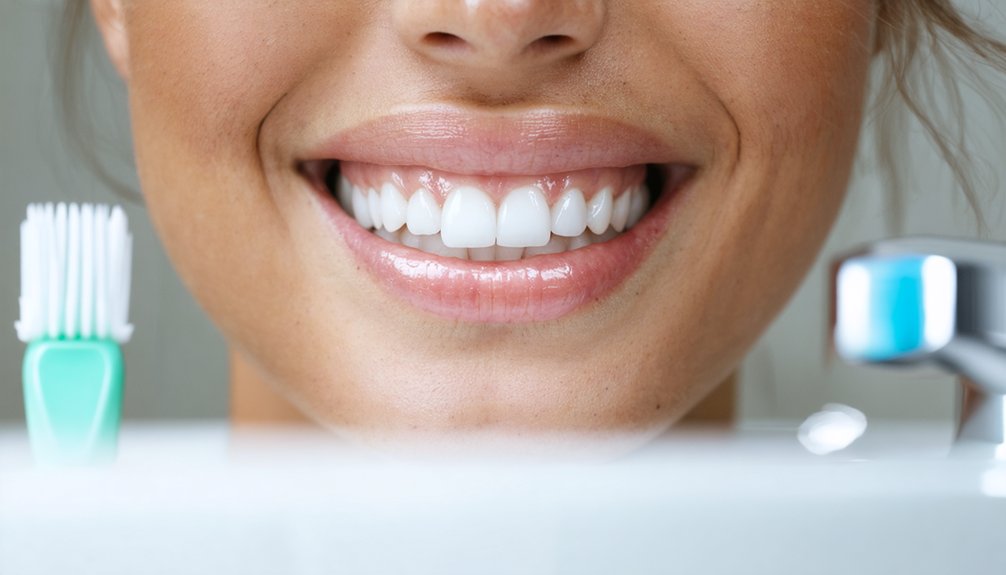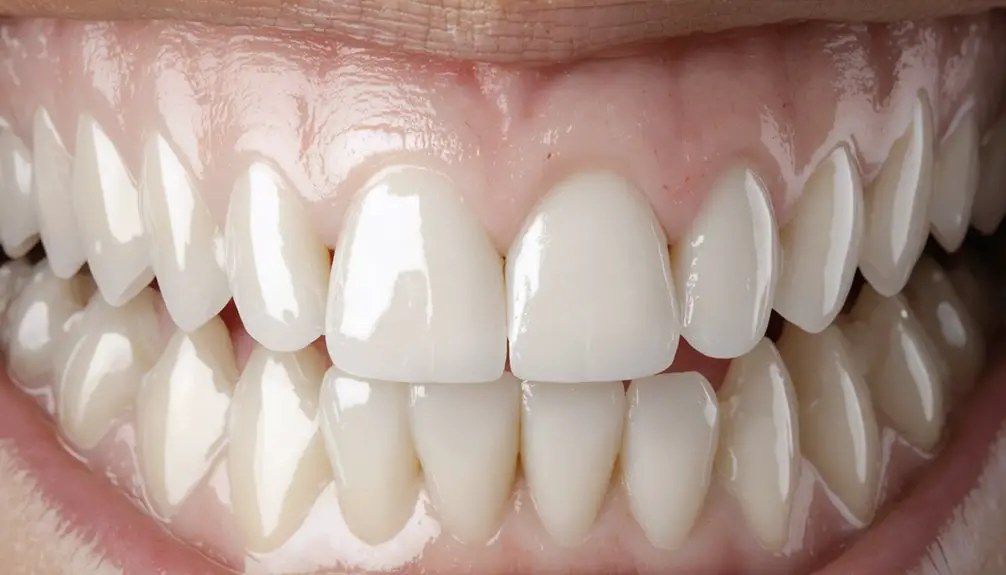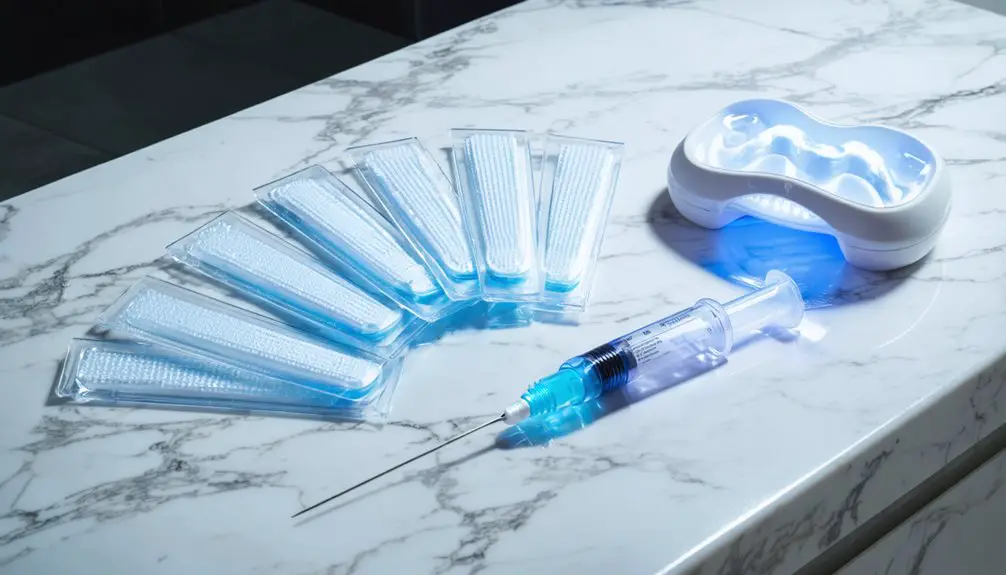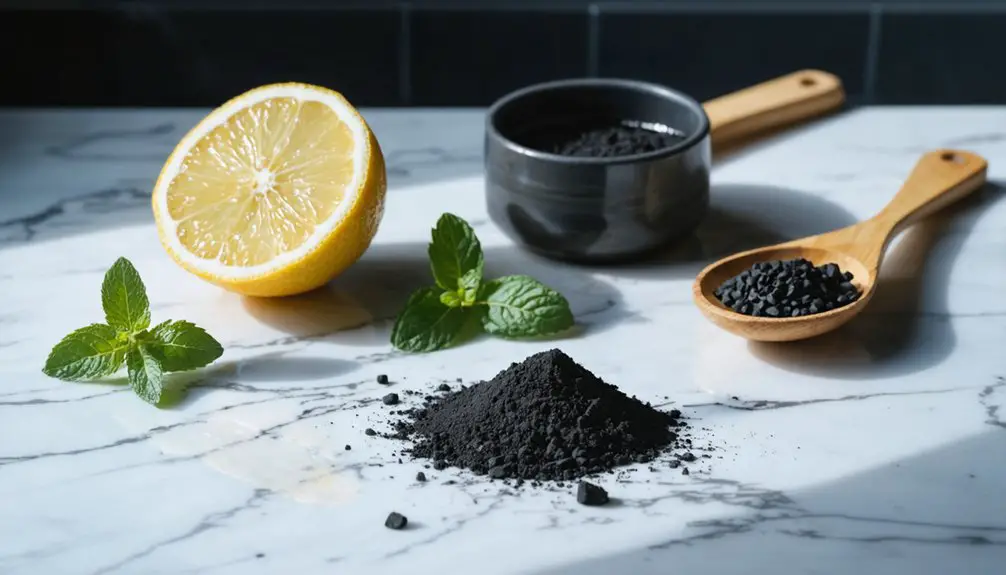To maintain long-lasting teeth whitening results, you’ll need to combine professional treatments with consistent aftercare. Brush twice daily with whitening toothpaste, avoid major staining foods like red wine and coffee, and rinse immediately after consuming acidic items. Use a straw when drinking dark beverages, and schedule touch-up treatments every 6-12 months. For ideal success, you’ll discover specific techniques and strategies that maximize your whitening investment.
Key Takeaways
- Professional treatments with 25-40% peroxide concentration provide the most reliable and longest-lasting results, up to 8 shades lighter.
- Avoid major staining culprits like red wine, coffee, dark berries, and tobacco products, especially within 48 hours after treatment.
- Maintain daily oral hygiene with whitening toothpaste, gentle brushing twice daily, and regular flossing for optimal results.
- Schedule touch-up treatments every 6-12 months and maintain regular dental checkups to protect enamel health.
- Use straws for dark beverages and rinse mouth immediately with water after consuming staining foods or drinks.
Understanding Professional vs. At-Home Whitening Options
When deciding between professional and at-home teeth whitening, it’s crucial to understand how these options differ in their approach, effectiveness, and overall value.
Professional techniques utilize powerful hydrogen peroxide concentrations of 25-40%, delivering dramatic results of up to 8 shades lighter in just one session. You’ll receive expert supervision, precise application, and specialized equipment to guarantee the best outcomes. Dental professionals can monitor side effects and make adjustments during treatment to protect your teeth and gums. Professional treatments provide maximum whitening in about three visits.
While these treatments cost around $300 or more, they offer immediate, long-lasting results that can exceed a year.
At-home strategies use gentler formulas with 3-10% peroxide concentrations. You’ll achieve 3-6 shades of improvement over several weeks of consistent use.
While more affordable at about $50 per kit, these methods require longer treatment periods and more frequent touch-ups. They’re ideal if you prefer flexibility and have mild staining to address.
Smart Diet Choices to Maintain Your Bright Smile
After investing in teeth whitening, you’ll want to steer clear of major staining culprits like red wine, coffee, and dark berries that can quickly undo your results.
Your beverage choices play an essential role in maintaining your bright smile, so opt for water, white milk, or clear drinks instead of cola, dark teas, or fruit juices. Eating crunchy produce like apples and carrots naturally helps clean teeth while you chew.
Making these smart dietary adjustments, combined with choosing light-colored foods like chicken, white fish, and non-acidic fruits, will help preserve your newly whitened teeth for longer periods. Using a soft-bristled toothbrush during regular brushing and flossing helps maintain whiteness while protecting sensitive enamel after treatment.
Avoid Major Staining Foods
Did you know that maintaining your newly whitened smile requires careful attention to your diet? Powerful staining agents lurk in many common foods and beverages you consume daily.
Dark berries, pomegranates, and beets contain natural pigments called chromogens that quickly adhere to your tooth enamel. Tomato-based sauces, soy sauce, and dark spices like turmeric can also leave lasting stains on your teeth. Consistent brushing habits help remove surface stains before they set in permanently.
Even healthy choices like black tea, fruit juices, and sports drinks pose risks due to their high pigment content and acidic nature. It’s especially important to avoid tobacco products since they cause severe discoloration.
The key lies in dietary moderation and smart consumption habits. When you do enjoy these foods, rinse your mouth immediately with water or use a straw for beverages. This simple practice helps minimize direct contact with your teeth and preserves your whitening results.
Smart Drink Choices Matter
Making smart beverage choices plays an essential role in maintaining your whitening results long-term. Water stands out as your best hydration option, effectively flushing away staining pigments and food particles throughout the day. Your teeth may experience temporary sensitivity with certain drinks.
When you’re craving variety, opt for skim milk, white wine in moderation, or clear herbal teas without artificial colors. Waiting at least 48 hours post-treatment before consuming any colored beverages is crucial for optimal whitening success.
You’ll want to develop strategic hydration habits when consuming potentially staining drinks. Always use a straw for beverages like coffee or dark sodas to minimize contact with your teeth.
Follow up by rinsing your mouth with water immediately after – but don’t brush right away if you’ve had acidic drinks, as this can damage softened enamel.
These mindful beverage choices and drinking techniques will help preserve your bright smile for months to come.
Essential Aftercare Practices for Lasting Results
When you’ve invested in teeth whitening treatment, proper aftercare becomes essential for maintaining those bright results. Contrary to common whitening myths, your newly brightened smile requires strategic care to protect your enamel and preserve its radiance. Following professional treatment, your teeth need consistent attention through specific practices. Since newly whitened teeth are more vulnerable to staining, extra precautions are necessary during the first 48 hours. Using a remineralizing mouthwash helps restore essential minerals to your teeth after whitening treatment.
- Brush gently twice daily with whitening toothpaste and floss once daily to remove stain-causing particles.
- Wait at least 30 minutes after consuming acidic foods before brushing to prevent enamel erosion.
- Rinse immediately with water after consuming potentially staining beverages or foods.
For ideal enamel protection, maintain regular dental checkups and stay well-hydrated. When consuming dark beverages, use a straw to minimize contact with your teeth.
Consider scheduling touch-up treatments every 6-12 months to maintain your bright smile while avoiding over-whitening.
Managing Tooth Sensitivity During Treatment
Tooth sensitivity during whitening treatments can greatly impact your comfort and results, yet it’s a manageable condition with proper understanding and care.
For effective sensitivity management, opt for products specifically formulated for sensitive teeth and work with your dental professional to create a personalized treatment plan that won’t overwhelm your teeth’s nerve endings.
To minimize nerve irritation, limit your whitening sessions’ duration and frequency while keeping your teeth well-hydrated throughout the process.
Use desensitizing toothpaste containing potassium nitrate or fluoride, and avoid extremely hot or cold foods immediately after treatment.
If you experience persistent sensitivity, your dentist may need to adjust your whitening protocol or recommend professional desensitizing treatments.
Remember to address any existing dental issues before starting your whitening journey to prevent complications.
Maximizing Your Whitening Treatment’s Effectiveness
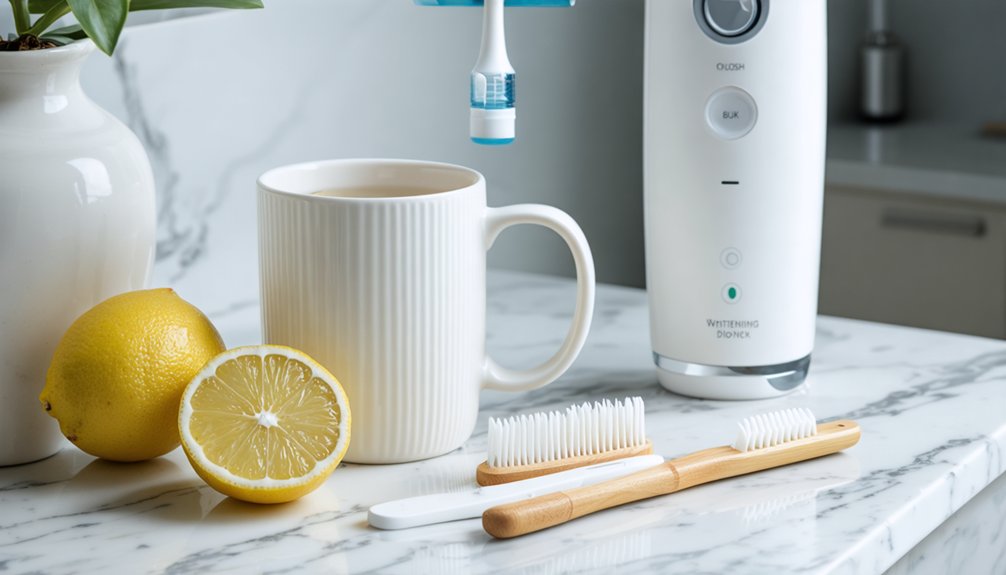
To achieve ideal whitening results, you’ll want to choose professional in-office treatments or dentist-supervised home bleaching over less effective over-the-counter options.
Following your treatment, it’s crucial to strictly adhere to your dentist’s aftercare instructions, including proper tray usage and timing guidelines if you’re using a take-home system.
You can protect your investment by avoiding staining substances like coffee, tea, and red wine immediately after treatment, while maintaining excellent oral hygiene practices to preserve your brighter smile.
Choose Professional Over DIY
The decision between professional teeth whitening and DIY solutions can greatly impact your treatment’s success and longevity.
Professional advantages include customized treatment plans, higher-concentration bleaching agents, and expert supervision that guarantees both safety and ideal results.
DIY limitations often lead to inconsistent outcomes, potential enamel damage, and the need for frequent touch-ups.
- Dentist-supervised treatments achieve up to 8 shades lighter in a single session, penetrating deeper into enamel.
- Custom-fitted trays guarantee even application and superior coverage compared to generic DIY options.
- Professional monitoring prevents sensitivity issues and protects your oral tissues from chemical exposure.
While DIY methods might seem cost-effective initially, professional whitening delivers superior, longer-lasting results that can extend beyond a year with proper maintenance, ultimately providing better value for your investment.
Follow Post-Treatment Care Guidelines
After investing in a professional teeth whitening treatment, following proper post-care guidelines becomes essential for maximizing and extending your results.
Start by avoiding staining agents like coffee, tea, and red wine for at least 48 hours post-treatment. To protect your sensitive teeth, use desensitizing toothpaste and steer clear of extremely hot or cold foods. These post-treatment precautions help minimize enamel erosion and maintain your bright smile.
Maintain gentle brushing techniques with a soft-bristled toothbrush, and wait 30 minutes after consuming acidic foods before brushing. When you do consume potentially staining beverages, use a straw to minimize contact with your teeth.
Stay hydrated by drinking plenty of water, and consider scheduling periodic touch-up treatments to maintain your results. Remember to attend regular dental check-ups to monitor your whitening success.
Maintain Smart Dietary Habits
Smart dietary choices play an essential role in maintaining your teeth whitening results long after your initial treatment. Your dietary modifications should focus on protecting your enamel while preventing new stains from forming. Select teeth-friendly foods that naturally support whitening and enamel protection.
- Choose crunchy fruits and vegetables like apples and carrots that act as natural stain removers while promoting healthy enamel.
- Incorporate dairy products such as white cheese and yogurt to maintain lighter tooth color and provide essential minerals.
- Opt for light-colored fruits and vegetables instead of staining foods like tomato sauce and dark berries.
During the first 48 hours post-treatment, you’ll want to be especially vigilant about avoiding staining substances.
Stick to water as your primary beverage, and maintain consistent hydration to support your body’s natural teeth-cleansing mechanisms.
Combining Treatments for Optimal Results
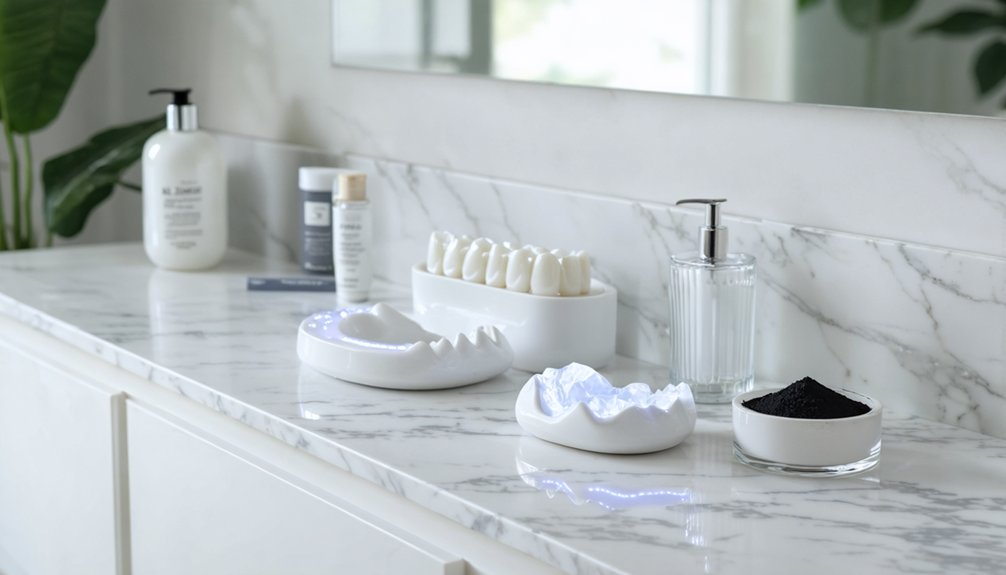
Maximizing your teeth whitening results often requires a strategic combination of different treatment methods.
Start with professional in-office whitening to achieve rapid color improvement, then maintain your results with at-home treatments using custom trays and 10% carbamide peroxide gel.
While you can safely incorporate OTC whitening toothpastes and rinses into your routine, don’t combine multiple professional whitening techniques simultaneously, as this may lead to unpredictable outcomes.
If you’re planning cosmetic dental work like veneers or crowns, complete your whitening treatment first to guarantee proper shade matching.
Your dentist can help coordinate these whitening techniques and treatment coordination for best results.
Remember to manage any sensitivity between sessions with desensitizing products, especially when combining different whitening approaches.
Warning Signs of Unsafe Whitening Practices
Recognizing the warning signs of unsafe teeth whitening practices can help prevent serious dental complications. Pay attention to symptoms that indicate overuse consequences, such as persistent tooth sensitivity to hot or cold stimuli, and gum inflammation or soreness that doesn’t subside within days.
Enamel erosion from improper whitening can lead to irreversible damage.
Once enamel is damaged by aggressive whitening treatments, there’s no going back – protect your teeth’s natural armor.
Watch for these critical warning signs:
- Teeth appearing translucent or unnaturally thin at the edges
- Prolonged sensitivity that persists even after completing treatment
- Gum tissue that becomes severely irritated, swollen, or develops blisters
If you notice any of these symptoms, stop whitening immediately and consult your dentist. They’ll evaluate the extent of any damage and recommend appropriate treatment options to protect your oral health.
Building a Long-Term Whitening Maintenance Plan
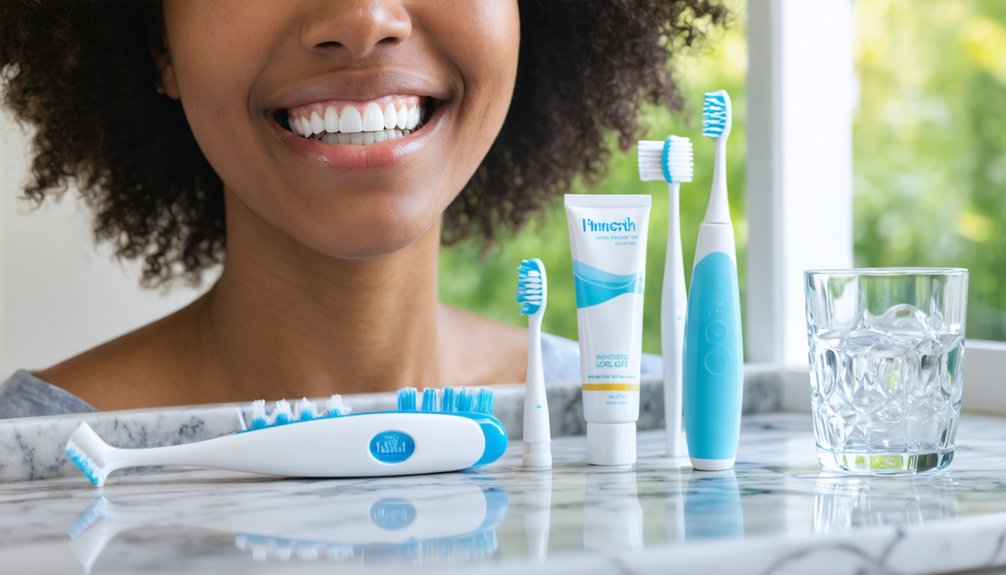
To maintain the brilliant results of your teeth whitening treatment, implementing a thorough maintenance plan is essential for long-term success.
Start by establishing a daily routine that includes whitening toothpaste and regular flossing to prevent stain buildup. You’ll need to determine your ideal whitening frequency based on your lifestyle and initial treatment type.
Incorporate maintenance products strategically, such as at-home touch-up kits and whitening pens for spot treatments. Schedule professional cleanings every six months, and consider touch-up treatments as recommended by your dentist.
Manage your diet by limiting staining substances and using straws for pigmented beverages. When consuming staining foods, rinse immediately with water.
Remember to address any sensitivity issues promptly with desensitizing treatments, and adjust your maintenance routine based on your dentist’s guidance.
Frequently Asked Questions
Can Teeth Whitening Damage Existing Dental Work Like Crowns or Veneers?
No, whitening effects won’t damage your dental materials, but they also can’t whiten existing crowns or veneers. The challenge is that your natural teeth may whiten, creating a potential color mismatch.
How Soon After Teeth Cleaning Should I Wait Before Getting Whitening Treatment?
Like a fresh canvas ready for paint, you’re perfectly prepared for whitening treatment immediately after teeth cleaning. If your gums are healthy, you can proceed same-day; otherwise, wait 3-5 days for healing.
Is It Safe to Whiten Teeth While Pregnant or Breastfeeding?
You’ll want to postpone teeth whitening during pregnancy due to safety concerns, but it’s generally safe while breastfeeding. Consult your dentist first, as pregnancy considerations may affect your treatment options.
Will Whitening Treatments Affect the Strength of Tooth Enamel Over Time?
When used properly, whitening won’t damage your enamel strength. However, you’ll need to limit whitening frequency and follow professional guidelines to prevent temporary softening or sensitivity issues.
Can Certain Medications Interfere With the Effectiveness of Teeth Whitening Treatments?
Yes, many medications can affect your whitening results through medication interactions that cause tooth staining, reduce saliva production, or weaken enamel. You’ll need customized treatment plans to guarantee ideal outcomes.
References
- https://www.thedentalspajersey.com/blog/teeth-whitening-statistics-2024
- https://www.alpinewhite.com/en/article/teeth-whitening-statistics/
- https://www.loudfamilydentistry.com/blog/teeth-whitening-related-statistics-on-effectiveness-and-sensitivity-incidence
- https://pmc.ncbi.nlm.nih.gov/articles/PMC4058574/
- https://pmc.ncbi.nlm.nih.gov/articles/PMC8352057/
- https://potachmitchelldental.com/2025/09/how-long-does-professional-teeth-whitening-actually-last/
- https://auraglow.com/blogs/articles/teeth-whitening-facts-statistics
- https://www.ada.org/resources/ada-library/oral-health-topics/whitening
- https://www.veenstradental.com/blog/at-home-vs-professional-teeth-whiteningwhats-the-difference-
- https://www.fairfaxfamilydentist.com/blog/whats-the-difference-between-professional-teeth-whitening-and-at-home-kits
